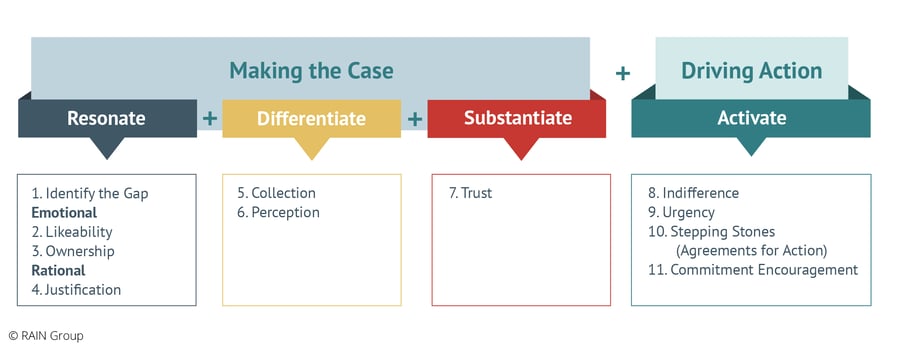Sales is about change. It’s about getting people to go from where they are—their current state—to a new and better place—their future state—or what we call the New Reality.
In our decades of work with clients globally and our proprietary research, we’ve identified 11 ways sellers can influence buyers throughout the sales process to guide them to their New Reality.
There are two primary ways influence plays a significant role in the sales process:
- Making the case for change
- Driving action
Your case for change is outlined in your value proposition and the three legs that make it up:
- Resonate: Buyers have to want and need what you’re selling
- Differentiate: Buyers have to see you as the best available option
- Substantiate: Buyers have to believe you can deliver on what you say you can
Once you’ve made the case, you have to drive action, or Activate.
The 11 Principles of Influence fall into these four categories.
11 Principles of Influence in Sales

Resonate
To make the case for change you need to Resonate both rationally and emotionally with buyers. It’s a mix of the two that becomes the impetus for action and change. It may sound cliché, but it’s true: people buy with their hearts and justify with their heads. The first four principles fall in the category of Resonate:
- Identify the Gap: Establish the gap between where the buyer is now and where they want to be. People know what they have, but they want to know what they’re missing. Give them the sense they’re missing something, and they'll naturally want to know more.
- Likeability: People buy from people they like. They interact with people they like. They build trust and relationships with people they like. Without likeability, you won’t have access to buyers to influence them.
- Ownership: To the extent a buyer emotionally owns a change—any kind of initiative they’re trying to accomplish—they’ll be more inclined to see it through, and to give it energy, focus, and attention. If a buyer sees it as someone else’s initiative, it won’t be at the top of their agenda.
- Justification: This principle appeals to the rational side of the buyer. Buyers need to be able to make a rational justification to themselves and others as to why they want or need to do something. For some ideas, here are 6 ways to communicate impact in sales.
Differentiate
It’s critical to stand out from others. To maximize your influence as you do, attend to the following:
- Collection of Distinctions: When you differentiate, you provide buyers with a mix of distinctions that set you apart from your competitors. Typically, it’s a combination of you as the seller, your offering, your company, and the results you can achieve that make up the mix of distinctions. When a buyer views you and your solution, as a whole, as different from other options, it’s influential in their decision making.
- Perception of Scarcity: People value rarity and don't want to miss out on an opportunity. When buyers view what you bring to the table as scarce, they’ll not only value you more, but also take action faster because they fear losing out.
Substantiate
Buyers have to believe you can deliver on your promises. The key influence principle here is:
-
Trust: Buyers buy from people they trust. They listen to people they trust. They give access to, spend time with, and help people they trust. The more trust you build, the greater the influence you’ll have. Here are ideas for building trust in sales.
It’s important to note that trust connects to each of the other principles as well. The more buyers trust you the more they’ll believe in your justification case, see you as distinct and scarce, trust your urgency case is real, and so on. Trust is core to being influential and applying each of these principles with the greatest success.
Driving Action
The first seven principles focus on making the case for change. Some sellers stop here thinking this will get the win. But the world is littered with sellers who’ve made the case for change and still lost a sale. You need to drive buyer action. These four principles can help you do that:
- Indifference: It’s okay to want a sale, but not to need it. Indifference is emotional detachment to the outcome of making the sale. Indifference is often best understood in light of its opposite: neediness. The more you seem like you need the sale, the less likely a buyer will view you as a peer and the more difficult it will be to sell.
- Urgency: When you make the case for change, you make the case for why act, but you also need to make the case for why now. To make that case, it’s important to establish a closing window of opportunity. As with the other principles, there are many ways to do it, it’s just critical that you make it happen—and you do so genuinely and honestly.
- Stepping Stones: Once people get on a path, they're much more likely to stay on that path. To the extent you can get buyers to make small agreements for action, you can get them to make bigger agreements for action. Stepping stones are about creating an interim step—something that makes the leap of faith of working with you much easier to take—by taking smaller steps in succession.
- Commitment Encouragement: Always strive to secure the next step. Research has shown that when you can get people to make verbal, written, and public commitments, they’re more likely to keep them. The best sellers ask for commitment at the right time, get signatures, and get buyers to communicate commitments publicly.
Take a look at these principles of influence and imagine that just a few come together. The buyer sees a big gap. They take great personal ownership of closing that gap. They can make the case to themselves and their peers that it needs to be closed and quickly. They see you as an obvious, differentiated best choice to help, and they trust everything you’ve put forth.
They have a clear, unobstructed path for moving forward, and you’ve collaborated with them along the way, building even more trust and bringing them ever closer to committing to the change. Then, they let you know in writing they’re moving forward and announce it internally.
Influential indeed.







